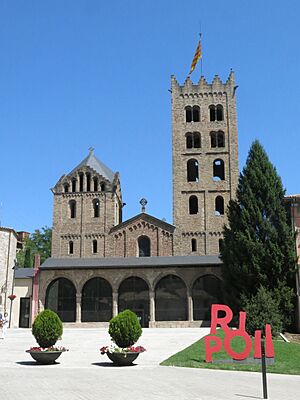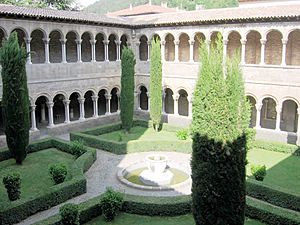Santa Maria de Ripoll facts for kids
The Monastery of Santa Maria de Ripoll is a very old and important building. It is a Benedictine monastery, which means it was a home for monks. The monastery is built in the Romanesque style, a type of building design from long ago. You can find it in the town of Ripoll in Catalonia, Spain. Even though parts of the church were rebuilt later, its carved entrance, called a portico, is a famous piece of Romanesque art.
Contents
A Look Back: The Monastery's Story
The Monastery of Santa Maria de Ripoll was started in the year 888. It was founded by a powerful leader named Count Wilfred the Hairy. He used the monastery as a way to help people settle and live in the area after he had won control of it.
Wilfred's son, Ridulph, grew up at the monastery. He later became the head of the monastery, known as an abbot. The monastery quickly grew bigger and more important. It was officially blessed again in 935, 977, and 1032.
This place became famous for its scriptorium, a room where monks copied books by hand. It also had a great school for learning. The monastery collected many manuscripts, which are old handwritten books. By 1046, they had 246 of them! One important book was the Gesta comitum Barcinonensium. This book, written by the monks, is thought to be the first history of Catalonia.
From 1070 to 1169, another monastery in France, the Abbey of St. Victor, looked after Ripoll. Santa Maria de Ripoll was the most important religious place in Catalonia until the 1400s. After that, it slowly became less powerful.
In 1428, a big earthquake badly damaged the monastery. It was then repaired, and some new parts were built in the Gothic style. The monastery became the burial place for important rulers like the Counts of Barcelona. It was also a huge center for learning, with a very large library.
Sadly, in 1835, a fire destroyed the library and many of the monastery's old records. Later, parts of the building were pulled down. But in 1886, people started rebuilding it. The main church was blessed again in 1896.
Exploring the Monastery's Design
The original church had a main area and four side sections. It had rounded ceilings called barrel vaults. The current church was rebuilt in 1896. It still looks like the old church but now has only two side sections. Inside, you can find the tombs of important counts, including Wilfred the Hairy.
The cloister, which is an open courtyard surrounded by covered walkways, has more of the original old parts than the church itself. The first floor of the cloister was built between 1180 and the early 1400s. The second floor was added later, in the 1400s and 1500s.
The cloister has arches supported by small pairs of columns. These columns have carved tops, called capitals. Each capital has a different design. They show pictures inspired by old stories or everyday life.
The main entrance, or portal, is a fantastic example of old Catalan Romanesque carving. Even though it was damaged by fires and fixed later, it's still amazing. The front part has carvings from the mid-1200s. These carvings are split into seven rows.
The top rows show God on a throne, with symbols of the Four Evangelists and angels. The middle rows tell stories from the Bible, like David and Solomon, and Moses. At the bottom, you can see strange animals that are linked to the visions of the prophet Daniel.
Two statues, almost destroyed, stand on either side of the portal. They are of St. Peter and St. Paul. Around them are more carved scenes, including stories like Cain and Abel and Jonah.
Important People Buried Here
Many important people were buried at the Monastery of Santa Maria de Ripoll. Some of them include:
- Wilfred the Hairy
- Ramon Berenguer III, Count of Barcelona
- Ramon Berenguer IV, Count of Barcelona
- Bernat Tallaferro, Count of Besalú
- Radulf, Abbot of Ripoll (Wilfred the Hairy's son)
Other important people were also buried here, but their exact burial spots are now unknown:
- Sunifred II, Count of Barcelona (also known as Sunyer)
- Miro I, Count of Barcelona
- Berenguer Ramon I, Count of Barcelona
See also
 In Spanish: Monasterio de Santa María (Ripoll) para niños
In Spanish: Monasterio de Santa María (Ripoll) para niños
- Romanesque architecture
- Romanesque art
- List of regional characteristics of Romanesque churches
- Santiago de Compostela Cathedral
- History of medieval Arabic and Western European domes




